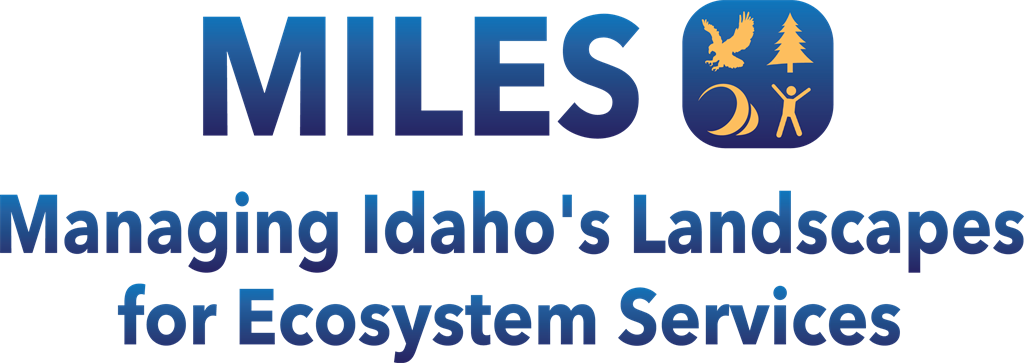Summary & Purpose
Vegetation biomass estimates across drylands at regional scales are critical for ecological modeling, yet the low-lying and sparse plant communities characterizing these ecosystems are challenging to accurately quantify and measure their variability using spectral-based aerial and satellite remote sensing. To overcome these challenges, multi-scale data including field-measured biomass, terrestrial laser scanning (TLS) and airborne laser scanning (ALS) data, were combined in a hierarchical modeling framework. Data derived at each scale were used to validate an increasingly broader index of sagebrush (Artemisia tridentata) aboveground biomass. First, two automatic crown delineation methods were used to delineate individual shrubs across the TLS plots. Second, three models to derive shrub volumes were utilized with TLS data and regressed against destructively-sampled individual shrub biomass measurements. Third, TLS-derived biomass estimates at 5 m were used to calibrate a biomass prediction model with a linear regression of ALS-derived percent vegetation cover (adjusted R2 = 0.87, p < 0.001, RMSE = 3.59 kg). The ALS prediction model was applied to the study watershed and evaluated with independent TLS plots (adjusted R2 = 0.55, RMSE = 4.01 kg, normalized RMSE = 35%). The biomass estimates at the scale of 5 m is sufficient for capturing the variability of biomass needed to initialize models to estimate ecosystem fluxes, and the contiguous estimates across the watershed support analyzing patterns and connectivity of these dynamics. Our model is currently optimized for the sagebrush-steppe environment at the watershed scale and may be readily applied to other shrub-dominated drylands, and especially the Great Basin, U.S., which extends across five western states. Improved derived metrics from ALS data and collection of additional TLS data to refine the relationship between TLS-derived biomass estimates and ALS-derived models of vegetation structure, will strengthen the predictive power of our model and extend its range to similar shrubland ecosystems. The corresponding data set is composed of an attributes list in comma separate value format (.csv).
Date of Publication or Submission
11-15-2015
DOI
http://dx.doi.org/10.18122/B2WC74
Funding Citation
The project described was supported by NSF award number IIA-1301792 from the NSF Idaho EPSCoR Program and by the National Science Foundation.
Data Source Credits
See journal article for credits. (doi:10.1016/j.agrformet.2015.06.005)
Data Attributes
See journal article for detailed information. (doi:10.1016/j.agrformet.2015.06.005)
Map Area
43.316276
Map Area
-116.682686
Time Period
Data Collected in 2012
Privacy and Confidentiality Statement
Idaho EPSCoR MILES is explicitly compliant with federal and state laws surrounding data privacy including the protection of personal financial information through the Gramm-Leach-Bliley Act, personal medical information through HIPAA, HITECH, and other regulations. Human Subject Data: All such data (e.g., surveys) will be collected and managed only by personnel with adequate human subject protection certification.
Use Restrictions
Data will be provided to all who agree to appropriately acknowledge the National Science Foundation (NSF), Idaho EPSCoR and the individual investigators responsible for the data set. By downloading these data and using them to produce further analysis and/or products, users agree to appropriately acknowledge the National Science Foundation (NSF), Idaho EPSCoR and the individual investigators responsible for the data set. Use constraints: Acceptable uses of data provided by Idaho EPSCoR include any academic, research, educational, governmental, recreational, or other not-for-profit activities. Any use of data provided by the Idaho EPSCoR must acknowledge Idaho EPSCoR and the funding source(s) that contributed to the collection of the data. Users are expected to inform the Idaho EPSCoR Office and the PI(s) responsible for the data of any work or publications based on data provided.
Disclaimer of Warranty
BOISE STATE UNIVERSITY MAKES NO REPRESENTATIONS ABOUT THE SUITABILITY OF THE INFORMATION CONTAINED IN OR PROVIDED AS PART OF THE SYSTEM FOR ANY PURPOSE. ALL SUCH INFORMATION IS PROVIDED "AS IS" WITHOUT WARRANTY OF ANY KIND. BOISE STATE UNIVERSITY HEREBY DISCLAIMS ALL WARRANTIES AND CONDITIONS WITH REGARD TO THIS INFORMATION, INCLUDING ALL WARRANTIES AND CONDITIONS OF MERCHANTABILITY, WHETHER EXPRESS, IMPLIED OR STATUTORY, FITNESS FOR A PARTICULAR PURPOSE, TITLE AND NON-INFRINGEMENT.
IN NO EVENT SHALL BOISE STATE UNIVERSITY BE LIABLE FOR ANY SPECIAL, INDIRECT OR CONSEQUENTIAL DAMAGES OR ANY DAMAGES WHATSOEVER RESULTING FROM LOSS OF USE, DATA OR PROFITS, WHETHER IN AN ACTION OF CONTRACT, NEGLIGENCE OR OTHER TORTIOUS ACTION, ARISING OUT OF OR IN CONNECTION WITH THE USE OR PERFORMANCE OF INFORMATION AVAILABLE FROM THE SYSTEM.
THE INFORMATION PROVIDED BY THE SYSTEM COULD INCLUDE TECHNICAL INACCURACIES OR TYPOGRAPHICAL ERRORS. CHANGES ARE PERIODICALLY ADDED TO THE INFORMATION HEREIN. COMPANY AND/OR ITS RESPECTIVE SUPPLIERS MAY MAKE IMPROVEMENTS AND/OR CHANGES IN THE PRODUCT(S) AND/OR THE PROGRAM(S) DESCRIBED HEREIN AT ANY TIME, WITH OR WITHOUT NOTICE TO YOU.
BOISE STATE UNIVERSITY DOES NOT MAKE ANY ASSURANCES WITH REGARD TO THE ACCURACY OF THE RESULTS OR OUTPUT THAT DERIVES FROM USE OF THE SYSTEM.
Recommended Citation
Li, Aihua; Glenn, Nancy F.; Olsoy, Peter J.; Mitchell, Jessica J.; and Shrestha, Rupesh. (2015). Data for Aboveground Biomass Estimates of Sagebrush Using Terrestrial and Airborne LiDAR Data in a Dryland Ecosystem [Data set]. Retrieved from http://dx.doi.org/10.18122/B2WC74



